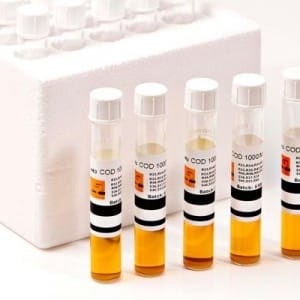Tubetest, Phosphate 12P, for 25 Tests, 0-12mg/L P
Catalog No :
CAS Number :
Brand :
In Stock
Specifications:
| Application | Water Quality Analysis | ||
| Storage Temperature | Room Temperature | ||
| Product Type | Photometer Reagent | Forms | Liquid |
| Product Brand | Palintest | ||
| Product Grade | Analytical grade | ||
Phosphate/12P Tubetest
Test Method Technical Information
Tests For: Phosphate in Natural, Drinking Water and Wastewater
Tests Range: 0–12 mg/L P
Reagent Chemistry Used: Ascorbic acid/molybdenum blue
Basis of Test Method: Standard Method 4500-P-E, US EPA method 365.1, 365.3
Method Detection Limit*: 0.09 mg/L
Limit of Quantification**: 0.27 mg/L
*The Method Detection Limit (MDL) is defined as the minimum measured concentration of a substance that can be reported with 99% confidence to be different from the method blank results.
**The Limit of Quantification (LOQ) is the smallest quantity that can be detected with reasonable certainty for a given analytical procedure.
Testing for Phosphate
Phosphates are extensively used in detergent formulations, in food processing and in industrial water treatment processes. These phosphates may be in the form of orthophosphates or are broken down to orthophosphates in the process concerned. Agricultural fertilisers normally contain phosphate minerals. Phosphates also arise from the breakdown of plant materials and are found in animal wastes.
Phosphates can therefore enter water courses through a variety of routes particularly domestic and industrial effluents and run-off from agricultural land. Phosphate is an important control test for natural and drinking waters.
Whilst phosphates are not generally considered harmful for human consumption, they do exhibit a complex effect on the natural environment. Phosphates are associated with eutrophication of water and with rapid unwanted plant growth in rivers and lakes. Phosphates present in natural water pass through into drinking water supplies.
en over the range 0–1 mg/L N. The test can however be extended to cover the range 0–20 mg/L by a simple dilution technique.
The Palintest Tubetests Phosphate/12P test provides a simple method of measuring orthophosphate levels over the range 0–12 mg/L P.
Reagent Chemistry
In the Palintest Tubetests Phosphate/12P method, the phosphate reacts under acid conditions with ammonium molybdate to form phospho-molybdic acid. The compound is reduced by ascorbic acid to form the intensely coloured ‘molybdenum blue’ complex. A catalyst is incorporated to ensure complete and rapid colour development, and an inhibitor is used to prevent interference from silica. The reagents are provided in the form of a pre-dispensed tube and two tablets for maximum convenience. The test is simply carried out by adding a sample of the water and one of each tablet.
STEP ONE
 Add 2 mL of sample to a Tubetest.
Add 2 mL of sample to a Tubetest.
STEP TWO
 Use this to "blank" the instrument. Fit the Tubetest adapter to Lumiso, insert tube and press Blank.
Use this to "blank" the instrument. Fit the Tubetest adapter to Lumiso, insert tube and press Blank.
STEP THREE
 Continue with the same tube by adding a Tubetest Phos No1 tablet. Crush and stir, until fully dissolved.
Continue with the same tube by adding a Tubetest Phos No1 tablet. Crush and stir, until fully dissolved.
STEP FOUR
 Then, add a Tubetest Phos No2 tablet and crush and stir.
Then, add a Tubetest Phos No2 tablet and crush and stir.
STEP FIVE
 Ensure cap is tight, then invert tube a few times to mix.
Ensure cap is tight, then invert tube a few times to mix.
STEP SIX
 Place in the cell holder and press Measure.
Place in the cell holder and press Measure.
STEP SEVEN
 Allow timer to count down 10 minutes. Concentration of Phosphate will then be displayed.
Allow timer to count down 10 minutes. Concentration of Phosphate will then be displayed.




 0
0
